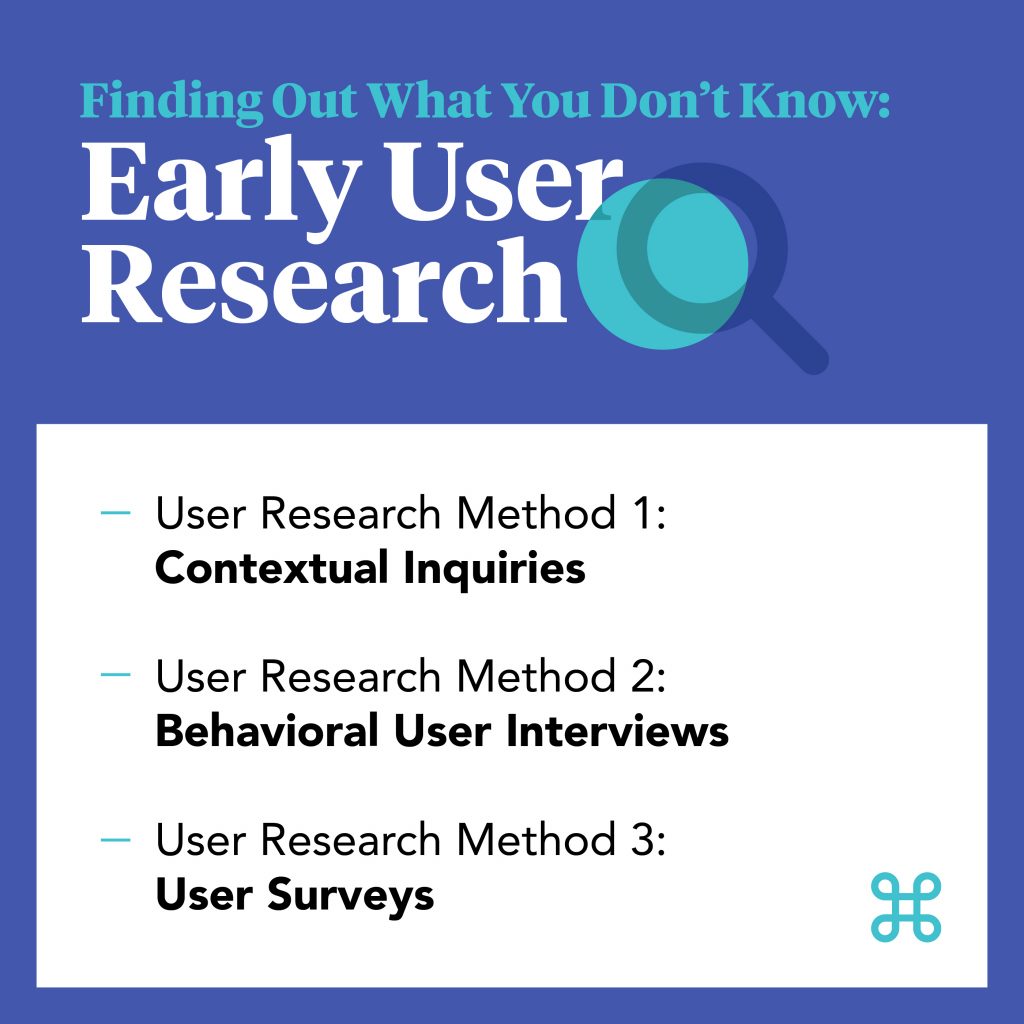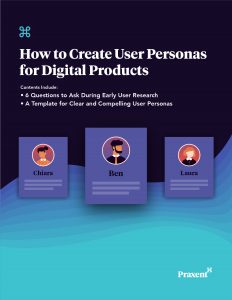
3 Keys to Practical User Research for New Products [“Define Your Product” Series]
User research for new products can be expensive, but it doesn’t have to be.
Using simple, cost-effective methods, conduct user research at the beginning of a product development project. The relatively minimal effort will save thousands in the long run.
Aim to achieve these three deliverables from a user research initiative for new product development:
- User personas, a first-stage definition of potential target users
- Data and user information collected from contextual inquiries or user surveys
- A first-stage value proposition and product-need definition
Keep reading to discover the methods and tools needed to execute practical yet effective user research for new products.
This article is the second in a design-thinking series titled “Define Your Product.”
Read the first article in the series to identify and cultivate disruptive potential in your product: Cultivate Disruptive Potential in Your Product Concept.
Read the final article in the series, “How to Identify & Test a Product’s Value (Before Investing Thousands).”

Finding Out What You Don’t Know: Early User Research
The more research you can do before building a prototype, the more relevant and accurate your prototype will be. In an ideal world, your company will invest time and resources into some early-stage user research, collecting as much concrete information as you can about the people who will use your product and the context in which they will use it.
Conducting some form of any of these three types of user research is feasible and necessary for new products, even if you find yourself with an extremely limited user research budget.
Before You Begin: Create Provisional Personas
Provisional personas (also known as proto-personas) reflect what you initially believe about the intended users of your product. Together with your product strategist and one or two other stakeholders, formulate hypothetical bios that highlight the roles, behaviors, motivations and tendencies of the various people who you believe will use your product.
The resulting profiles serve as a starting point when performing user research for new products. They represent your perceived audience — the people you learn from before you know who to enlist for actual usability testing.
For instance, you may start your research by finding and speaking with people who match your provisional personas, only to find that the results point you to an entirely different person or circumstance.
Later on, you’ll replace provisional personas with more accurate user personas based on real user research.
How to Create User Personas for Digital Products
Create clear and compelling user personas in Sketch or Keynote using our free templates.
Download includes a guide to understanding user personas and six questions to ask during early user research.
>> Download the e-book and templates for creating user personas in Sketch and Keynote.
User Research Method 1: Contextual Inquiries
This is a user research activity for new product development that involves visiting perceived target users in the context of when and where they would be using your product. For example, if you have a product idea for enterprise software, you can visit an office where people who match your provisional persona are performing enterprise-software-related activities.
This type of user research is extremely helpful for new products when you don’t yet know what questions you should be asking to define your idea.
Follow these steps to conduct an effective contextual inquiry that gets to the heart of what you need to know:
1. Study.
Carefully observe people’s behavior, fears, motivations and pains when doing the activities related to your product idea.
2. Hypothesize.
Use your observations to further hypothesize who would use your product, and why and when they would use it.
3. More Research.
Based on your hypothesis, write questions for more narrowly focused interviews or surveys to further piece together the people and scenarios surrounding your product idea.
Remember that what people say is often different from what they actually do.
Conduct contextual inquiries with the intention of discovering the true story behind why and how people perform activities the way they do. Look for insight that users won’t necessarily share or know to share in a survey.
User Research Method 2: Behavioral User Interviews
Ideally, you’ll pair this method with one or several contextual inquiries. Use your findings from the contextual inquiry to further define user personas and context. Then, find an even closer match of people to interview.
Focus your questions on validating or disproving your assumptions and getting to the heart of the motivations and fears surrounding relevant activities. We recommend creating a Jobs-to-Be-Done style interview to inspire deep discovery.
>> Learn more about “jobs to be done” in the first article from this series, “How to Identify & Test a Product’s Value (Before Investing Thousands)”
User Research Method 3: User Surveys
User interviews and in-person observations dig deeper than the “yes,” “no” and multiple choice answers in a survey. That being said, user surveys can be a helpful supplement to user research for new products.
User surveys collect qualitative data through open-ended questions and quantitative data through closed questions.
Follow these guidelines to make the most out of user surveys:
- Best practice for user surveys often involves an initial round of open-ended questions that really allow you to see a full spectrum of possible motivations and fears.
- Based on responses, you can develop an informed set of closed-ended questions to validate your assumptions. It’s easier to consolidate large amounts of quantitative data, so the closed-ended questions will allow you to analyze a wider range of answers.
Value Proposition & Product-Need Definition
Using the results of your user research, compile a list of all the user-inspired factors that should influence your product’s value proposition:
Jobs to be Done
Based on your research, why will people “hire” this product? What do they expect it to do for them?
>> How to Innovate Without Wasting Millions (And Why Jobs to Be Done Really Works)
Pain Points
What user struggles will this product address? What solutions do people currently turn to in the absence of this product? What frustrates the with those current solutions?
Needs
What are the core functions the product must perform well for the people who use it?
Environmental Factors
No products are used in a vacuum. Consider your observations of the context in which the product will be used. What aspects of the environment will influence how the product should operate?
Lastly, synthesize your user research findings for the new product, and create a succinct and clear value proposition and product-need definition.




Leave a Reply